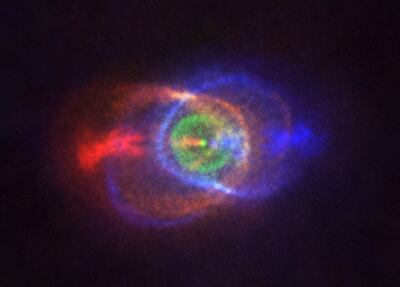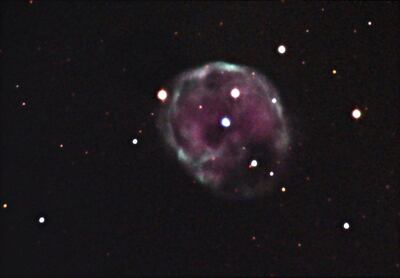Editor’s note: A version of this has been previously published on the author’s website.
In several billion years, when the sun has burned up its hydrogen fuel, it will expand into a red giant star and puff off its outer atmosphere. The phase may last an additional couple of billion years. Eventually, the puffs expand outward as a planetary nebula that will shine for perhaps 10,000 years. Mostly out of fuel, the core shrinks into a compact object called a white dwarf, something the size of Earth but 200,000 times as dense. The white dwarf glows at 175 million degrees Fahrenheit until it becomes a dead cinder called a black dwarf.
This is how stars of typical size end their reigns, students learn in astronomy class. It’s pleasant to picture our final goodbye as an intricate, colorful planetary nebula like the Cat’s Eye Nebula — a lovely flare of spirals and jets waving fare-thee-well to the cosmos.
Is our star really destined for a beautiful, complex planetary nebula?
The heavens display a sprinkling of planetary nebulas — called planetary because, through a telescope, one may look like a planet although it is really a gigantic glowing gas cloud. Some are beautifully complex, like the Cat’s Eye.
What if they are only complex in the case of binary stars, doubles that evolved and stayed together? According to the Australia National Telescope Facility, Sydney, up to 85% of stars may be in systems of multiples. (That’s reasonable, as stars often form in groups that condense about the same time from primordial clouds of gas and dust.) Our sun is atypical in that it has no companion star.
Now we are learning more about the complicated life stories may occur frequently to stars that happen to be part of binary systems, and the results raise questions about how our sun will go out. The findings were discussed in a study highlighted in a Feb. 5 news release by the European Southern Observatory, based in Garching, Germany. The study was published in the March 2019 issue of the European journal Astronomy & Astrophysics.

A photograph based on radio telescope imaging, distributed by the observatory, illustrates the way in which “common envelope” evolution occurs in stars. In the photo, the double star system HD101584 — a red giant and a lower-mass companion star, located in the southern constellation Centaurus, the Centaur — has developed an amazing pattern of loops and swirls in their common gas envelope.
Distance to the system isn’t certain. The study’s authors settled on an average of about 3,300 light-years.
The photo was taken by the Atacama Large Millimeter/submillimeter Array of telescopes, or ALMA, which is a set of radio antennas in Chile. The analysis was supplemented by observations made with the 39-foot-diameter APEX radio telescope. Both facilities are located in the Atacama Desert and operated by the European Southern Observatory and partners.
The ALMA array is a powerful radio telescope facility, with 66 antennas — 54 of them measuring 39 feet across, the rest 23 feet in diameter. The telescopes act together to combine their data, with a resolution equal to that of “a single giant telescope as large as the whole array,” according to the observatory.
In May 2014 and October 2015, ALMA focused more than 30 antennas on the system, obtaining readings on 12 types of molecules in the stars’ gas envelope. When analyzed they traced out a pattern that told the story of the confrontation between the dying star and its companion.
The release quotes Hans Olofsson of the Chalmers University of Technology, Sweden, who led the study, as stating, “The star system HD101584 is special in the sense that this ‘death process’ was terminated prematurely and dramatically as a nearby low-mass companion star was engulfed by the giant.”
The release adds (including British spellings): ”As the main star puffed up into a red giant, it grew large enough to swallow its lower-mass partner. In response, the smaller star spiralled in towards the giant’s core but didn’t collide with it. Rather, this manoeuvre triggered the larger star into an outburst, leaving its gas layers dramatically scattered and its core exposed.
”The team says the complex structure of the gas in the HD101584 nebula is due to the smaller star’s spiralling towards the red giant, as well as to the jets of gas that formed in this process. As a deadly blow to the already defeated gas layers, these jets blasted through the previously ejected material, forming the rings of gas and the bright bluish and reddish blobs seen in the nebula.”
Although they approached one-another inside their common envelope, the stars did not merge.
The nebula’s structure looks like a series of rather tight loops in the ALMA photo because from Earth the view is almost directly down a tube of gas. A photograph in the study, “HD 101584: circumstellar characteristics and evolutionary status,” shows that from the side the envelope structure looks like an extremely elongated bowtie, like an 1850s cravat.
Only about one in five planetary nebulas was believed to have its origin in a common envelope of gas, the study says, but “this may be a (significant) understatement.... Therefore, the question whether or not a close companion is a pre-requisite for the formation of PNe (planetary nebulas) appears to remain open.”
The study says that currently, astronomers don’t know how a single star can produce a planetary nebula with complex shapes and motions. If a close companion is required for that kind of planetary nebula, the Sun’s future may be sort of drab.

Some type of planetary nebula seems inevitable for the sun. After all, nobody doubts that it will become a red giant star that must puff off its atmosphere — and that has to go somewhere. Somewhere like a nebulous mass of gas.
So, the romantic idea of our sun’s demise creating a fancy nebula may need to be thrown out.
If it won’t form a complicated structure but will produce some sort of planetary nebula, instead of the lovely Cat’s Eye, our singleton star might end up with an unsightly blob of a planetary like the Skull Nebula.
Joe Bauman, a former Deseret News science reporter, writes an astronomy blog at the-nightly-news.com and is an avid amateur astronomer. His email is joe@the-nightly-news.com.


